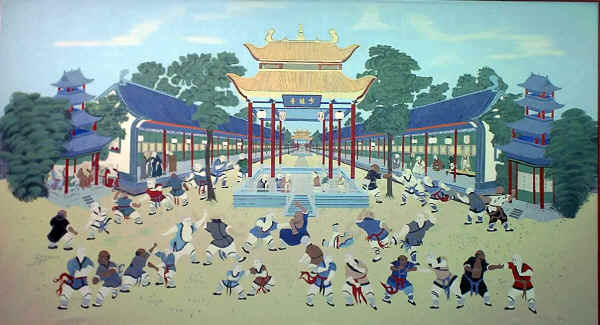By Aaron Vyvial | July 31, 2015

Painting of Shaolin Warrior Monks in Training
“Because of Shaolin’s relative anonymity during the reign of the Qing, it became a natural recluse for anti-Manchu activity. Hundreds (if not thousands) of men took refuge at the temple, shaved their heads and became “monks;” warriors, perhaps, but not Buddhist priests. And so, a large number of men, forming a core of resistance against the Manchus, were living, and hiding, within the gates of Shaolin.
Between what the Manchus had done to the Northern Temple, and being inundated with a virtual flood of anti-Manchu sentiment, the abbots in the South decided to adhere to their ancient doctrine of Just Protection; they began plans for a full-scale revolt against Manchu authority.
In preparation for battle, the decision was made to abandon the classical Shaolin systems as the tools for a revolt. The Manchus already had access to the Northern Temple and were familiar with much of the Shaolin’s methods. In addition, they had to train an army of new students, and the classical styles took, on average, 10 to 15 years to master. By the elders’ estimation, time was not on their side.
They ultimately agreed that a new system had to be created to have the advantage-something the Manchus had never seen, and would not be able to defend. It had to be more effective, and more direct than any other system. And, it had to be learned in three to five years.
The masters drew from their enormous pool of collective experience to flush out only the best, most effective principles, strategies and techniques.
The hall within the temple (Fukien) where the five elders of the temple met to discuss their plans was renamed the “Ving Tsun” hall. This translates to “eternal springtime,” signifying hope for the future of their struggle against the Manchus.
However, with much of the new system in place, and the army ready to begin its training, the Manchus attacked the Southern Temple. They had been tipped off about the revolt (many say by one of the Temple’s own elders, Bak Mei), and promptly surrounded the temple, burned it and slaughtered the monks as they attempted to flee the burning complex. In one swift stroke, the Southern Temple was destroyed and most of the monks and would-be rebels were killed.
Another one of the elders, a nun named Ng Mui, survived the raid, and later codified the new (Southern) Shaolin system.
In a legendary tale of defiance (that’s another story!), Ng Mui taught the art to a young girl (Yim), to whom Ng gave the name, “Ving Tsun.” Via Yim Ving Tsun, the system became a Family Style (now known as Ving Tsun or Wing Chun).” above text is an excerpt from the Inside-Kung Fu article, The Shaolin Connection written by Eric Oram
The Ving Tsun system started during the Ching Dynasty under the rule of the Emperor Yung Jing. The Siu Lam Temple was burned down. Five of the senior monks hid themselves in different mountains. The nun Ng Mui lived in White Crane temple in Wan Nam. She saw a snake and a crane fighting. This gave her an idea to modify the kung fu she knew. She met a girl named Ving Tsun and taught her the new kung fu so she could defend herself against a bully who wanted to force her to marry him.
Ving Tsun later divided her new system into siu nim tao, chum kiu, biu je, mui fah jong, luk dim poon kwan, and bot jom doa. Her followers named the style after her. She passed the art on to her husband Leung Pok Toa, who passed it on to Wong Wah Po. Wong Wah Po passed it on to Leung Lan Kwai, Leung Yee Tai and Leung Tsun.
Leung Tsun passed it on to Fung Wah and Chan Wah Shuen. Grand Master Yip Man learned the complete system from Chan Wah Shuen. Grand Master Yip Man is the leader of the style now. From what I have heard, that is how the family tree has grown. I have set the legend of Ving Tsun in stone carvings for the future generations. —Grand Master Moy Yat, 1967 The previous text is a translation of three seals from the Kuen Kuit which detail the origins and lineage of the Ving Tsun family.
Since the Ving Tsun Kung Fu System was developed during the Shaolin and Ming resistance to the Qing Dynasty many legends about the creation of the art were spread to confuse the enemy, this might include the story of Yim Ving Tsun. This explains why there is no written historical record of the system’s beginnings. Many like to look at the story of Yim Ving Tsun as the story of Southern China and and the Han people.

